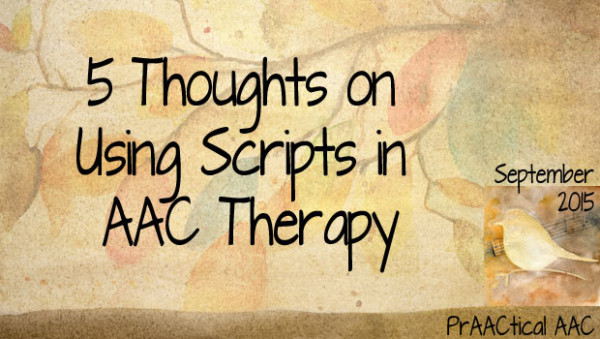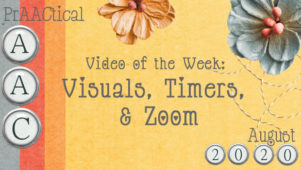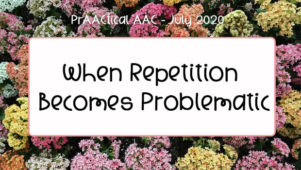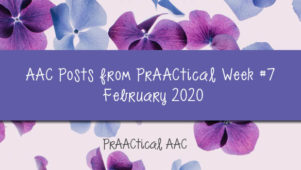5 Thoughts on Using Scripts in AAC Therapy

As we all know, it’s a big leap from having an AAC system to being able to use it functionally. For many of our prAACtical friends, one of the areas in which they struggle is conversation. It is no easy thing to have even a brief social interaction. We’ve written before about the use of scripting, a powerful strategy that we can use to help learners build conversational skills.`
- Scripts provide structure. As clinicians and educators, we understand that many of our learners do best when there is a clear beginning, middle, and end to an activity. For many people learning to use AAC, conversation is a VERY challenging thing because it can be quite amorphous. Scripting gives the learner practice getting comfortable with some of the skills that they need to use in conversation by adding the element of structure. The script has a clear starting point (e.g., “Look at this.” “How are things?” “I have something to tell you.”) and ways to keep the conversation going (e.g., “What do you think?” “Tell me about it.” “That’s right.”). Depending on the nature of the script, it may also include messages to wrap things up (e.g., “See ya later.” “Thanks for chatting.” “Nice talking to you.). Having a structure, gives the learner clear boundaries on what the expectations are for the conversation and that can radically improve his/her chances for success.
- Scripting is transitional strategy. In most instances, scripting is an intervention strategy that serves to help the learner gain experience with social interaction in a way that allows them to be successful and feel good about the exchange. As they gain experience, they gain both skills and confidence. That allows us to fade the script in favor of more generative and flexible communicative interactions. Scripting feels artificial because it IS artificial. The point is to use it to get the process of conversational exchanges started, then fade them and move to more spontaneous, authentic conversations. It is a good initial strategy for some, but it works best when the script is seen as a starting place, and not the end result.
- Scripting can reduce stress for the learner. The repetitive nature of using scripts allow learners to predict what will happen next, and for many communicators this reduces their anxiety. Don’t we all feel more relaxed when we know basically what is likely happen in a situation? Our AAC learners are no different. Being able to anticipate the flow of conversation allows them to mentally prepare and rehearse so that they enter the exchange with less anxiety.
- Visual supports can help teach AAC learners to use scripting. Why not combine two research-based strategies? Visual supports are a powerful teaching strategy and we’ve written dozens of posts on making and using them.Provide a visual representation of the script so that you and the client can refer to it during the learning process. Depending on the needs and abilities of the client your visual support can illustrate the sequence of turns, who takes each turn, what is said, how that is stored in the AAC device.
- Scripts can include flexible elements. Clinicians often shy away from scripting because it seems so un-natural. Life isn’t a play to be staged. Having a pre-planned strategy for what to say seems limiting and that rubs us the wrong way. As we said, it is a transitional strategy, but even in the beginning, it can seem stiff and restrictive. One way to make scripts more appropriate to a spontaneous situation is to build in a bit of flexibility. For some learners, we can do that with conversational starters (e.g., Can I tell you about___? Hey, I want to talk about ___). In therapy, we may practice this when they bring up something that happened as in the exchange below
- SLP: Uh oh! You don’t look happy. Did something upset you?
- Learner: Elevator.
- SLP: Oh. Something was wrong with the elevator?
- Learner: No
- SLP: Something happened in the elevator?
- Learner: Yes.
- SLP: I want to hear about that. It sounds like you have a story to tell me. What’s one of our conversation starters that we can use to get started?
- Learner: Can I tell you about…?
- SLP: That’s the one I was thinking of. [Pause] So, if you put that together with elevator, you’ve got a perfect beginning.
- Learner: Can I tell you about…a problem…in the elevator?
- SLP: Absolutely! I’m afraid to hear what happened…
In this example, the SLP used scaffolding to build a single word topic-setter into a more robust start to the conversation. It’s only a start, but you get the idea. Once the SLP works with the client to flesh out the story, they can then practice it using a conversational script. Doing this takes a topic that the AAC learner is highly motivated to share with people and allows him/her to embed those into a real conversation that has the scripted elements that facilitate success for the beginning conversationalist.
One final note: Scripting is a strategy that works with several kinds of learners, not just those who struggle with social understanding. The dance of conversation is complex, and can seem mysterious to some AAC learners. Others understand the dance, but need help practicing the steps in order to get fluent. Either way, scripting is a strategy that can be helpful. Do you use it with your AAC learners? We’d love to hear about it.
Filed under: PrAACtical Thinking
Tagged With: intervention strategies, scripting, visual supports
This post was written by Carole Zangari





3 Comments
Thanks so much for this. This offers some clarification – even for my non-AAC students but who are at the same social-communication level. It’s good to remember that this is a transitional strategy. It’s just hard to be patient sometimes! 🙂 It’s especially difficult for those of us who have high schoolers/post-secondary students and know that we won’t have time to work on skills past this transition. We have to let them go with these strategies alone and hope hope for the best.
I know what you mean, Lily. When working with the older students, I think we feel time breathing down our necks. There is so much we want to do and so much we CAN do, given the time. One thing that I am experimenting with is involving families a LOT more with the older students, shifting the focus of my teaching to the caregivers who will be with them for a lifetime. It’s tricky to pull this off, but we are trying to see if this will make a difference. Thanks for taking the time to comment. 🙂
This is a great idea – and actually, I was attempting to make some scripts for my students as well. However I’m struggling with how they should look; my original idea was to make scripts completely from icons on my students’ core vocabulary boards, and do “skits” with them (for example “How are you?” “I am good” “Let’s go….” etc) so that either myself or another student could use them together. But I work with the mod-severe population and I think that format was overambitious. Do you have any better ideas for how to make them simple (and clear enough for my non-readers) but complex enough that we can build conversation skills? Thank you!